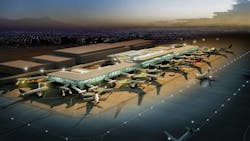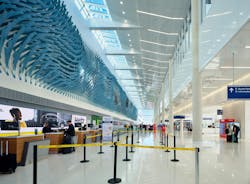Building the AI-Enabled Airport: Designing Intelligent, Seamless Passenger Experiences
It is time for us to officially retire the term passenger processing. For decades, the aviation industry ‘processed’ passengers through landside drop-off and security to get them onto planes. Speed, safety, and efficiency were the dominant objectives while the vision of personalized, seamless experiences remained elusive. But now, with the advancement of AI across the passenger journey, the curated passenger experience is not only possible, it is inevitable.
Airports once defined by infrastructure and logistics are now so much more than transportation hubs: they're expected to be ever-evolving, intelligent ecosystems. Beyond adding screens and digital kiosks, the ideal is a connected airport—an environment that responds in real-time, anticipates traveler needs, and delivers personalized occupant experiences.
The shift toward more intelligent capabilities has accelerated in recent years amidst the prioritization of touchless technologies. While this progress enables better real-time information sharing and has laid the foundation for meaningful change, the broader vision for a connected airport is still a work in progress.
Central to this shift is artificial intelligence. While early applications like chatbots, facial recognition, and automated kiosks, can be found in most airports today, there is more to achieve before it is truly a seamless passenger experience. Today’s airports must reimagine the entire journey, from curb to gate (and beyond), by rethinking collaboration across the travel ecosystem. And with The International Air Transport Association predicting a record 4.99 billion travelers in 2025, the need has never been greater.
What a Connected Airport Really Means
A connected airport is more than one outfitted with the latest technologies. It’s a cohesive, intelligent environment where systems, people, and services work together. At its core, a connected airport is one that anticipates the needs of travelers and responds in real-time.
Imagine this:
· Your airport parking is automatically reserved based on your itinerary
· You breeze through a biometric-enabled security lane
· Wayfinding signs adapt to your walking speed
· Dining recommendations are tailored to your dietary needs and gate location
· If a connection is tight, your boarding pass updates and directions reroute instantly
Some airports around the globe are beginning to build out this functionality. In fact, 95% of aviation leaders say they are actively exploring AI to enhance the passenger journey. But the full vision? That requires a lot more collaboration and smarter use of the data that’s already being collected.
In my work with airports globally, I’ve seen these challenges firsthand. The real blocker isn’t a lack of ideas or technology, it’s the ownership, governance, and contractual barriers that keep data and services in silos. And yet, the passenger doesn’t care who owns what. They just want the journey to work. The full value of a connected ecosystem is possible only by integrating data and intelligence across airlines, airports, border security, concessions, and third-party providers.
From Fragmented Systems to Connected Journeys
One of the biggest hurdles airports face today isn’t the lack of data, it’s that the data lives in silos. Airports collect massive volumes of information: flight schedules, passenger flows, facility availability, and even environmental conditions.
However, much of this data is locked away in disconnected platforms. Airports, airlines, security agencies and third-party vendors all have separate systems to manage their own data sets. Passengers interact with all of them, often without realizing that the underlying infrastructure is extremely fragmented. On top of this, travelers are actively seeking unified solutions: 56% want a single airport app that streamlines their journey and provides access to all services in one place.
From the business side, these silos are compounded by a reluctance to share data. Even when the information isn’t especially sensitive, airlines often see it as a competitive differentiator and hesitate to share it with partners. The result is a disjointed traveler experience.
To move forward, a shift toward data interoperability is necessary. That means building systems that speak to each other, share real-time updates, and protect passenger privacy through consent-driven models. When these systems connect, personalization becomes possible.
Personalization Is Infrastructure-Driven
There’s a tendency to talk about AI like it’s magic: press a button, and voilà, personalization appears. But it takes careful coordination behind the scenes. To make personalization meaningful and reliable, we need:
Robust systems and good data hygiene
· Real-time data exchange between airports, airlines, and third-party vendors
· Systems built to share, not hoard, information
· Clear consent frameworks that prioritize passenger privacy
And most importantly, travelers need to see real value. They can be willing to share data, like preferences or identity, when they see tangible benefits in return, such as faster screening, better wayfinding, or real-time gate updates.
The good news? Some of this infrastructure is already being built. From predictive maintenance systems to security wait time forecasting to smarter gate and staffing coordination, AI is quietly improving airport performance (even in ways passengers may never notice).
AI Supports People—It Shouldn’t Replace Them
There’s a natural concern that more automation could make airports feel colder or more impersonal. But the opposite is often true. In fact, one of AI’s biggest advantages is its ability to enhance the human side of travel. When AI handles repetitive tasks like scanning boarding passes or predicting maintenance issues, staff can focus more on what really matters: boosting the occupant experience.
Airport staff remain essential in areas like customer care, accessibility services, and crisis response. That might mean guiding a non-English speaker to their gate, assisting a traveler with reduced mobility, or calmly navigating a weather delay. Those moments still need a human touch, empathy and critical judgement.
The opportunity here is to upskill staff with AI tools, and with predictive dashboards, translation assistance, or workflow automation, airports can elevate both employee satisfaction and passenger service. The big picture? AI is the co-pilot, but humans are still in the cockpit.
Building Toward an AI-Enabled Airport
Many airports are already using AI, however, broader transformation requires strategic intent. With the aviation AI market projected to reach $32.5 billion by 2033, the opportunity for thoughtful AI deployment has never been more urgent. Starting with achievable milestones then scaling from there. Whether that means leveraging cross-system data exchanges, to machine learning for predictive cleaning and resource management, or even intelligent facility performance monitoring.
Airports need to understand their passengers: what they value, how they move, and where they engage. From parking reservations and TSA line management to various terminal concessions, each touchpoint is a chance to build trust and deliver value. It’s a shift in how we think about the airport experience, from reactive infrastructure to operations that guide, support, and adapt to travelers.
Why it Matters
AI’s promise in aviation isn’t innovation for innovation’s sake. It’s delivering smarter, simpler, and more human travel experiences. From guiding a nervous traveler through an unfamiliar terminal to making sure their luggage gets to the right carousel, when thoughtfully deployed AI can eliminate friction, personalize support and create the frictionless journey travelers increasingly expect.
About the Author

Chris Runde
Vice President
Chris is Vice President of Aviation at Introba, a leading global consulting and engineering firm within Sidara—a collective of renowned companies shaping the future of the built environment. In this role, he helps clients solve their most complex business challenges by delivering innovative yet practical solutions. Chris has held numerous aviation-related positions in the public and private sectors, including the creation and management of the Airport Innovation Accelerator at the American Association of Airport Executives (AAAE) and launching PreCheck as a Federal employee with TSA.
Chris is proud to support industry initiatives, including serving as the co-lead for the recently created Artificial Intelligence Working Group under the Airport Council International – North America and as a board member of the Smart Airport Technologies Association.



